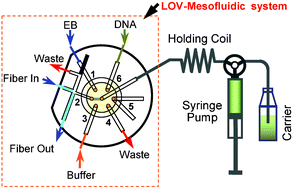A DNA assay protocol in a lab-on-valve meso-fluidic system with detection by laser-induced fluorescence
Abstract
An automatic protocol for in-situ assay of dsDNA is presented by employing a micro-sequential injection lab-on-valve meso-fluidic system, which facilitates precise fluidic handling at the 0.1–10 µl level. Sub-nano-liter to a few micro-liters of DNA sample and ethidium bromide (EB) solutions were introduced into the meso-fluidic system, where EB binding onto DNA takes place and an intercalated DNA–EB adduct was formed, which was afterwards excited in the flow cell of the LOV by a 473 nm laser beam, and the emitted fluorescence was monitored in-situvia optical fibers. The experimental variables, i.e., pH of the buffer solution, the concentration and volume of EB solution, the reaction time and the fluid flow rates, were investigated. By loading 600 nl sample and 1.0 µl EB solution, a linear calibration graph was obtained within 0.03–3.0 µg ml−1 (dsDNA), and a detection limit (3σ) of 0.009 µg ml−1 was achieved, along with a sampling frequency of 60 h−1 and a precision of 1.9% at the 1.0 µg ml−1 level. The detection limit was further improved to 0.006 µg ml−1 by increasing the sample volume to 2.0 µl. Plasmid DNA in E. Coli extraction and λ-DNA/Hind III in four synthetic samples were assayed by using this procedure. For the plasmid DNA, a good agreement with the documented UV method was obtained, while spiking recoveries for the synthetic samples were 95.6–103.4%.


 Please wait while we load your content...
Please wait while we load your content...